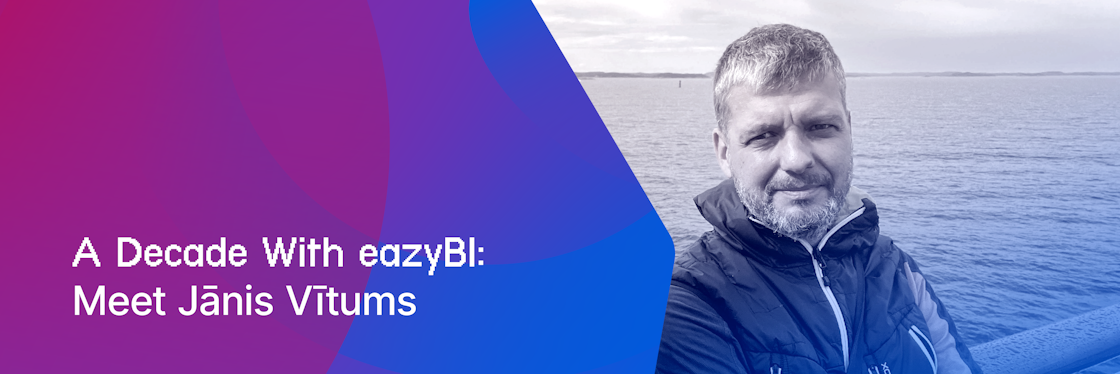

Preserving Sun for Long Northern Nights
During summer, lots of Latvians prepare jams and winter stock to last through the winter. Jānis Baiža, one of the most experienced eazyBI developers, takes it a step further by saving solar energy with solar panels to use in the darker seasons. Read his story on how eazyBI helps to answer the main question: Is it worth it?
Installing Solar Panels: Questions Behind Strategic Investment
A few years back, I thought about using greener electricity and decided to get solar panels for my home. The main question was: how long would it take for the investments to pay off? My initial calculations did not match the promised timeframe of 6 to 8 years, so I did more accurate computations. Using my Ruby programming skills, I analyzed my household electricity bills based on hourly market prices. I found out that it might take 15 to 25 years to pay off, depending on the provider and investment. With some additional encouragement from the seller, we decided to invest and embrace a greener approach to our energy consumption.

As with every investment, you would like to know the actual gain and the time it takes to repay the initial investments. To get more accurate data, we added an intelligent meter to our system to see instant energy generation/consumption and get data snapshots every five minutes. I combined those data with the hourly electricity market price from Nord Pool to convert power kWh (kilowatt-hours) to actual costs.
Additionally, I needed to calculate how much the same amount of consumed electricity would cost without panels installed.
Preparing data
You can try to calculate and interpret a few lines manually, which I did the first few months. It got more challenging as months passed, so I did the most obvious thing for the eazyBI employee—I decided to use eazyBI.
Before importing data into eazyBI, I used the Phyton programming language to prepare data for further analysis, as merging those two sources (i.e., data from the Solar Panel and market prices) was challenging.
In my app, I tracked how much power we generated, consumed, and sent back to the grid. I also retrieved data on electricity I bought from the market and combined this information with the electricity hourly market prices. Based on that, I calculated the total amount paid and the amount I would pay if I did not have my own solar energy. Looking back, I might have skipped the precalculations and used eazyBI to import data directly, but as they say, "If it works, do not touch it!". I learned firsthand that preparing and mapping data are usually the most complex steps in reporting.
I created a custom eazyBI data import from my Python app via REST API, initially only in my local development environment. Later, to share my insights with my colleagues, I moved it to the eazyBI Cloud public account; creating and using the eazyBI Cloud public plan is completely free for everyone!

As you can see from the import mapping screen, I imported all numbers as Measures tied to the Time dimension and invented the Hours dimension, as all electricity rates were hourly based.
Data mapping is a trial-and-error process; for instance, I do not use some of the imported measures in my reports. However, the documentation has a guide on how to do it.
How long can I live with my solar energy?
When I had data for a more extended period, one question I tried to answer using eazyBI reports was: What is the generated and consumed electricity ratio? Or, in other words, how long can I live using Solar Panel energy?
Here, let me explain how we "store" solar energy in Latvia. One way is to accumulate the energy in the power grid. In reality, it means that the generated but unused electricity is pushed into the network and later taken back from the network when we need additional electricity, for example, during night hours. We only pay to transfer the electricity back from the grid. Once I have used my generated and accumulated energy, I start buying it from the market. The tricky part is that the accumulated amount is zeroed on the 1st of March (previously—1st of April), and then counting begins from zero.
So, I created a report comparing two primary measures: daily generated and consumed electricity.
I needed a way to tell eazyBI to start new cumulative calculations every April (now March). The eazyBI founder Raimonds suggested using a Time dimension Fiscal hierarchy, and it worked.
First, I plotted both measures on the timeline across my "fiscal" year to see when my consumed electricity (dark blue line in the chart below) exceeds the generated amount (red line). Also, I used the standard calculation option “Time ago” to compare data with the previous year (light blue and pink lines in the chart).

The results were not a surprise for me—by mid-September when the daylight gets shorter and electricity is also needed for heating, my household consumes more energy than solar panels generate. It was the same last year.
Using another standard calculation—"Cumulative sum"—I compared the cumulative generated (light blue dotted line) and consumed energy (pink dotted line) to see when I had to start buying power from the market.

Last year, it was at the end of December; the same seems to be the case this year as well. So, using the option to preserve sunlight in the electricity grid, I can rely on my own electricity for almost three more months.
Household energy-consuming pattern
eazyBI reports also gave me insight into the electricity usage in my household throughout the year. I compared generated (dark blue columns in the chart below) and bought power (yellow columns) with actual consumption (red line).

As you can see, the peak of consumed energy is during the winter months. That’s when our heating system (a heat pump) uses the most power, aside from lights and home appliances. Even though solar panels are ineffective in autumn and winter, I depend entirely on the market energy only during January. In December, stored energy is still used; in February, the sun slowly gets back. Looking at the chart, I am mentally prepared for higher electricity bills for four upcoming months, but I will be fully back on my solar energy in April!
Unveiling the Payback Period
Let's revisit the main question: How long will it take to repay my solar panel system?
For that, I made another report that shows just numbers. I used a Gauge chart with the "Values only" option.
I created a custom calculation for the payback period. It is based on the initial investment divided by the difference between the amount paid for the energy and the potential costs incurred without solar panels. All prices include not only the electricity rates but also additional fees that are specific to our country's legislation. If you want to retract my exact calculations, please get in touch with support@eazybi.com!

Right now, it looks like it'll take about ten years to pay back. It is impacted by many factors, from how much sun we get in a particular year to the electricity prices in the market. More sun means more electricity generated; higher electricity price means more money saved using electricity generated by Solar Panels.
My Takeaway
There are no fast returns on Solar Panel investment; however, even knowing the numbers before installing them, I would go for it again. First of all, solar panels are a way for individuals to decrease the use of non-renewable energy.
My main goal was to become more independent from external factors regarding energy in my household. When I started the project, the war in Ukraine had not begun, and thus, the following fluctuations in the energy market. Knowing all that, I would have invested even more and installed Solar Panels with all the allowed capacity.
Regarding eazyBI reporting, it helps me track the energy generation and consumption ratio and forecast my investment payback. Reports also give me better insight into household electricity usage; I am mentally more prepared when winter comes.







